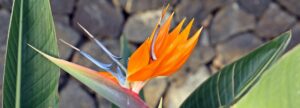Colorful folk festivals
The typical folk festivals, the Romerías, are directly related to the Catholic calendar of saints. On the richly decorated ox carts, the Tinerfeños in their traditional costumes accompany the procession of the local saint, who is led from a chapel to the main church. It is not particularly serious, however, because a Romería is more of a happy, nostalgic self-portrayal of the Tinerfeños and their rural life.
As everywhere in Spain, Semana Santa, Holy Week, is the most important religious period. In La Laguna it has a special meaning. During the processions, the penitents, led by brotherhoods with high, pointed hats, sometimes barefoot to the beat of the drums, flock to the main church to show their piety.
The most deeply rooted festival in Tenerife is the Feast of Corpus Christi. As soon as June approaches, real works of art in the form of huge carpets with religious motifs made of flowers and colored Teide sand are made in various places, which cover the path on which the procession then moves. You can surely marvel at the most beautiful path in La Orotava.
The largest festival in Tenerife takes place in honor of the patron saint of all Canary Islands, the Blessed Virgin of Candelaria, and attracts believers and visitors from all Canary Islands on August 15th. Not to be missed if you are on vacation in Tenerife at this time.
Carnaval is celebrated without any religious background, because it goes back to pagan rituals. For three weeks in February, the approach of spring is celebrated with numerous parades and dancers in colorful costumes, the election of the Reina del Carnaval, the carnival princess, and the burial of the sardine. A festival of superlatives! Only the Carnival of Rio de Janeiro is even more splendid!
strive
The traditional costumes that are worn on the opening day of every fiesta and romería as well as for the traditional Bailes de Magos (peasant dances) are peasant like the music. The most famous costume comes from the Orotava Valley.
The women wear wide skirts, decorated with bobbles, made of strong, colorfully striped wool, which are tucked up at the sides to reveal the petticoats. A red or black, richly embroidered bodice should go over the white blouse, and a short wool cape will keep you warm on cooler days. Silk scarves protect the head from the sun, while the sloping straw hat is more of an original than a useful attribute.
The men's costume consists of a white shirt and an embroidered vest with knee-length, wide trousers. Features include hand-knitted calf warmers and suede ankle boots. The black felt hat is usually pushed back on the neck.
However, not every costume is the same, they often differ from parish to parish in terms of both color and material, and sometimes even the marital status can be identified from the fabrics used.
Folk music
Although the samba strongly dominates at carnival and fiesta, the comparatively calm ways of Canarian folk music are also extremely popular with young people. They are part of their identity as Tinerfeños, which is presented proudly and confidently - whether with friends and family, at the local fiesta or at an event for tourists. Traditional country life awakens in the songs and dances and their themes are work in the fields, life in the village and the beauty of Tenerife. A calm rhythm is typical when the songs are sung to work. On the other hand, they sound cheerful and lively when the landscape is sung about. Isas, Folías and Malagueñas are the most popular pieces of music.
The different roots of this tradition reveal something about the origin of the islanders. There are unmistakably melancholic Portuguese melodies, surprising Arabic echoes and even earlier European fashions such as the polka have found their way into local music. The singers are accompanied by guitars, flutes and drums played simultaneously with great artistry. A fine example is the Ribbon Dance in San Pedro, where children with ribbons dance around a pole to the music of a flute and drum player. Castanets and the timple, a small four- or five-stringed lute, should not be missing either. A traditional folk music event includes para, row and round dances.
The most popular piece of music in the Canaries is the Canarian pasodoble, which the Catalan composer José Maria Tarridas created in 1935 and which immediately conquered the hearts of the Canarios. Years later, the Trinfen group Los Sabandeños changed the text. The group was founded in 1966 by students from La Laguna and is now considered the best traditional singing group in the Canary Islands. A memorial has even been dedicated to them.






